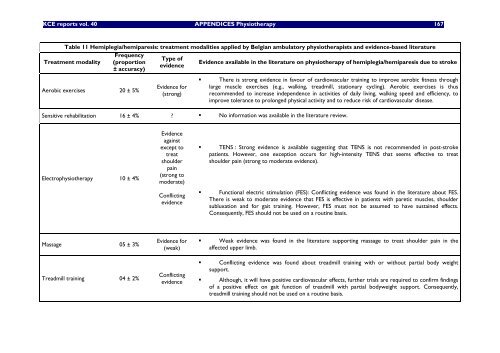Download the supplement (208 p.) - KCE
Download the supplement (208 p.) - KCE
Download the supplement (208 p.) - KCE
Create successful ePaper yourself
Turn your PDF publications into a flip-book with our unique Google optimized e-Paper software.
<strong>KCE</strong> reports vol. 40 APPENDICES Physio<strong>the</strong>rapy 167<br />
Table 11 Hemiplegia/hemiparesis: treatment modalities applied by Belgian ambulatory physio<strong>the</strong>rapists and evidence-based literature<br />
Treatment modality<br />
Frequency<br />
(proportion<br />
± accuracy)<br />
Aerobic exercises 20 ± 5%<br />
Type of<br />
evidence<br />
Evidence for<br />
(strong)<br />
Evidence available in <strong>the</strong> literature on physio<strong>the</strong>rapy of hemiplegia/hemiparesis due to stroke<br />
There is strong evidence in favour of cardiovascular training to improve aerobic fitness through<br />
large muscle exercises (e.g., walking, treadmill, stationary cycling). Aerobic exercises is thus<br />
recommended to increase independence in activities of daily living, walking speed and efficiency, to<br />
improve tolerance to prolonged physical activity and to reduce risk of cardiovascular disease.<br />
Sensitive rehabilitation 16 ± 4% ? No information was available in <strong>the</strong> literature review.<br />
Electrophysio<strong>the</strong>rapy 10 ± 4%<br />
Massage 05 ± 3%<br />
Evidence<br />
against<br />
except to<br />
treat<br />
shoulder<br />
pain<br />
(strong to<br />
moderate)<br />
Conflicting<br />
evidence<br />
Evidence for<br />
(weak)<br />
Treadmill training 04 ± 2% Conflicting<br />
evidence<br />
TENS : Strong evidence is available suggesting that TENS is not recommended in post-stroke<br />
patients. However, one exception occurs for high-intensity TENS that seems effective to treat<br />
shoulder pain (strong to moderate evidence).<br />
Functional electric stimulation (FES): Conflicting evidence was found in <strong>the</strong> literature about FES.<br />
There is weak to moderate evidence that FES is effective in patients with paretic muscles, shoulder<br />
subluxation and for gait training. However, FES must not be assumed to have sustained effects.<br />
Consequently, FES should not be used on a routine basis.<br />
Weak evidence was found in <strong>the</strong> literature supporting massage to treat shoulder pain in <strong>the</strong><br />
affected upper limb.<br />
Conflicting evidence was found about treadmill training with or without partial body weight<br />
support.<br />
Although, it will have positive cardiovascular effects, fur<strong>the</strong>r trials are required to confirm findings<br />
of a positive effect on gait function of treadmill with partial bodyweight support. Consequently,<br />
treadmill training should not be used on a routine basis.
















